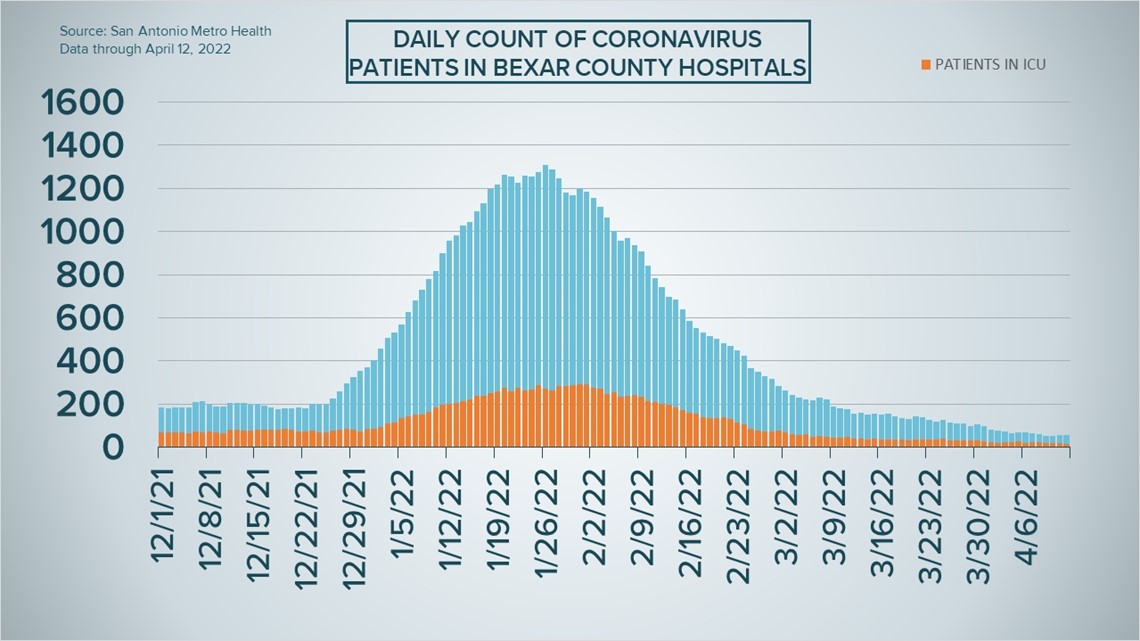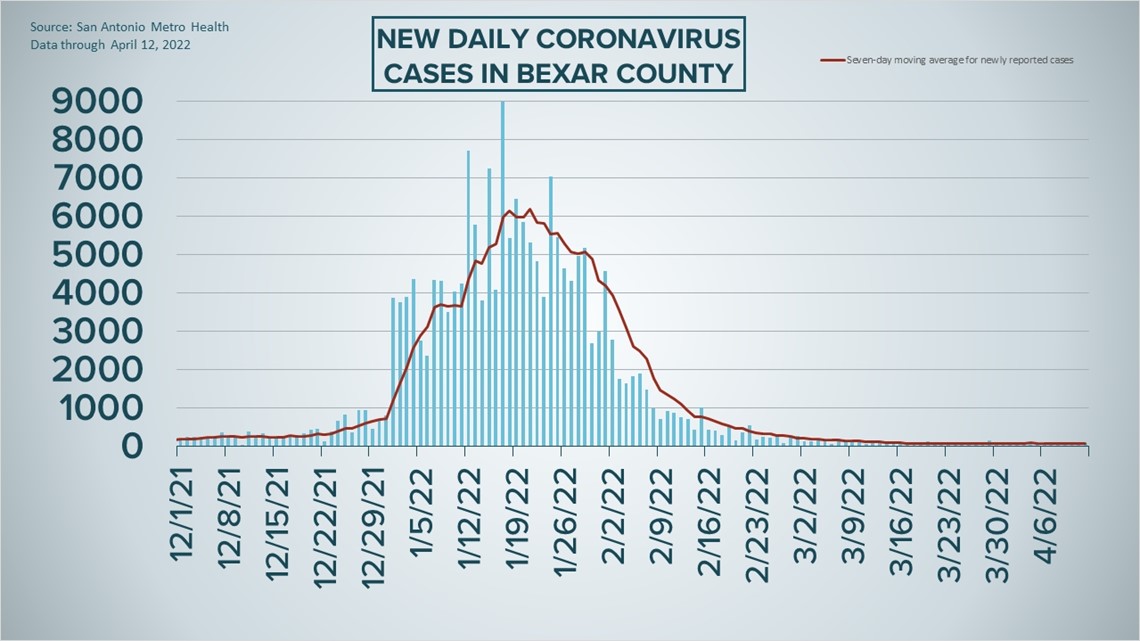SAN ANTONIO — COVID-19 infections have all but bottomed so far in April, with daily new-case counts wavering between 51 and 89 every day for the last two weeks in Bexar County.
Local health authorities reported another 61 and 64 new cases on Tuesday and Monday, respectively, bringing the San Antonio area's pandemic case count to 535,365. The seven-day new case average stands at 69.
Local coronavirus hospitalizations have more consistently declined this month. The number of patients battling virus symptoms in local hospitals has fallen by 31% since the start of the month, down to 57 on Tuesday. This time last month, there were still more than 150 patients in Bexar County health care facilities.
Of those 57 patients, 14 are in intensive care and 10 are using ventilators to help them breathe.
Bexar County's pandemic death toll remained at 5,319 on Tuesday after no additional virus-related deaths were reported. Meanwhile, Metro Health's COVID-19 risk level remained at "low" once again as the community continues to stave off a potential spring surge.
How Bexar County is trending




Vaccine Progress in Bexar County
The following numbers are provided by San Antonio Metro Health. A full breakdown can be found here.
- 1.438 million eligible Bexar County residents are fully vaccinated as of Monday, April 4.
- More than 496,000 eligible Bexar County residents have received their COVID-19 booster shot, as of Monday, April 4.
The CDC states that "when a high percentage of the community is immune to a disease (through vaccination and/or prior illness)," that community will have reached herd immunity, "making the spread of this disease from person to person unlikely."
The City of San Antonio breaks down the vaccination rates by zip code on Metro Health's Vaccination Statistics page.
Coronavirus in Texas
The total number of coronavirus cases in the state since the pandemic began grew by 1,989 on Tuesday, according to the Texas Department of State Health Services. That total includes 719 new confirmed cases and 1,270 new probable cases. More details can be found on this page.
Tuesday's figures bring the total number of Texans diagnosed with COVID-19 to more than 6.696 million.
An additional 38 Texans have died from virus complications, meanwhile, raising the statewide death toll to 86,279.
Coronavirus symptoms
The symptoms of coronavirus can be similar to the flu or a bad cold. Symptoms include fever or chills, cough, shortness of breath or difficulty breathing, fatigue, muscle or body aches, headache, new loss of taste or smell sore throat, congestion or runny nose, nausea or vomiting, and diarrhea, according to the Centers for Disease Control.
Most healthy people will have mild symptoms. A study of more than 72,000 patients by the Centers for Disease Control in China showed 80 percent of the cases there were mild.
But infections can cause pneumonia, severe acute respiratory syndrome, kidney failure, and even death, according to the World Health Organization. Older people with underlying health conditions are most at risk.
Experts determined there was consistent evidence these conditions increase a person's risk, regardless of age:
- Chronic kidney disease
- COPD (chronic obstructive pulmonary disease)
- Obesity (BMI of 30 or higher)
- Immunocompromised state (weakened immune system) from solid organ transplant
- Serious heart conditions, such as heart failure, coronary artery disease, or cardiomyopathies
- Sickle cell disease
- Type 2 diabetes
- The CDC believes symptoms may appear anywhere from two to 14 days after being exposed.
Human coronaviruses are usually spread...
- Between people who are in close contact with one another (within about 6 feet).
- Through respiratory droplets produced when an infected person coughs, sneezes or talks. These droplets can land in the mouths or noses of people who are nearby or possibly be inhaled into the lungs.
- Some recent studies have suggested that COVID-19 may be spread by people who are not showing symptoms.
Help stop the spread of coronavirus
- Stay home when you are sick.
- Eat and sleep separately from your family members
- Use different utensils and dishes
- Cover your cough or sneeze with your arm, not your hand.
- If you use a tissue, throw it in the trash.
Find a Testing Location
City officials recommend getting a COVID-19 test if you experience fever or chills, cough, shortness of breath or difficulty breathing, fatigue, muscle or body aches, headache, new loss of taste or smell, sore throat, congestion or runny nose, nausea or vomiting, or diarrhea.
Here's a Testing Sites Locator to help you find the testing location closest to you in San Antonio.
Latest Coronavirus Headlines
- One major US city is bringing back an indoor mask mandate
- COVID-19 is back on Broadway, knocking Broderick, Parker off stage
- COVID cases, death fall worldwide for second consecutive week, WHO says
- Research shows some Texas Latinos have doubts about effectiveness of COVID-19 vaccines
- A Costco policy enacted early in the COVID-19 pandemic is about to end
- Federal COVID-19 vaccine mandate gets OK from appeals court
- US orders consular staff to leave locked-down Shanghai amid COVID outbreak

